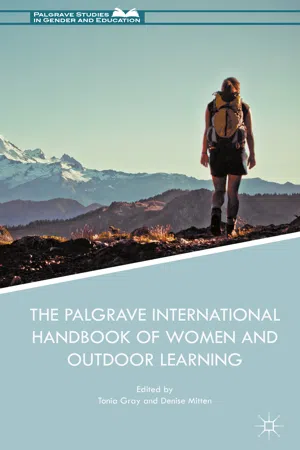Introduction: Be Bold for Change
Be bold. Be brave.
Be adventurous.
Be inquisitive. Ask questions. Be passionate.
Stand up. Speak up.
Be a trailblazer and a vanguard.
Be a truth teller who says the unsayable.
Be courageous. Be compassionate.
Be a leader. Be a lioness.
Be a naturally untamed woman
Facilitating change in outdoor learning environments.
—By authors
The genesis of the Palgrave International Handbook of Women and Outdoor Learning (PIHWOL) resembles a rhizomatic process spanning over three years. In June 2014, on a clear and crisp winter’s day, a group of Australian women gathered in a small cottage on the Hawkesbury Campus, Western Sydney University (WSU), Australia . The previous day, Denise Mitten had delivered an inspirational keynote address at the Centre for Educational Research symposium entitled Precarious Times: New Imaginings for Sustainability (see Malone, Truong, & Gray, 2017; Mitten, 2017).
As a highly esteemed feminist scholar and practitioner, Denise’s presentation provided a catalyst for us to explore the covert nature of the genderwashing of women in outdoor learning environments (OLEs). Unfortunately, many powerful and significant women in history are not well known or celebrated, and this trend is evidenced in the outdoors. Denise recounted a fundamental truth about Kurt Hahn—one that seems obvious in retrospect but was revolutionary at the time. The group was left bewildered, astonished, and speechless. In this instance, the history (or herstory) books for outdoor education (OE) were rewritten. Kurt Hahn, noted by many as the founder of the Outward Bound movement, surprisingly had a female co-founder for his first school, Schule Schloss Salem (Salem Castle School), where the concept of using expeditions for learning began (Mitten, 2011a). According to Hahn’s personal papers found by Nick Veevers and Pete Allison (2011), Marina Ewald co-founded the Schule Schloss Salem in 1920. Yet, her contributions have been erased by our profession’s “gender blinkers.” More importantly, her notoriety in the field of outdoor learning has been met with ambivalence and disaffection. This begs the questions: Were the blind spots societally imposed, or were they culturally constructed? Have we been experiencing unconscious bias and become immune to the chronic effect? The magnitude of this ambiguous situation was further enhanced in a recent conference presentation by Gray, Mitten, Loeffler, Allen-Craig, and Carpenter (2016):
In 1904, at the age of 18, Hahn suffered from sunstroke that left him with a recurring disability for the remainder of his life. He was frail in the heat and underwent major operations to relieve fluid in his head…. Hahn never completed a major expedition and had to regulate for the remainder of his life, how much time he spent outside and under what conditions.
We were left pondering: If Hahn were a woman, theorizing about the outdoor movement and never truly experiencing an extended expedition, would “s/he” be firmly entrenched in the history books? And more significantly, why has the outdoor industry never heard of nor promoted Marina Ewald? Why were the acumen, power, and authority bestowed on (white) men and not women? How can we accelerate the gender parity debate? Has women’s complicit inertia allowed this to happen, without raising our red flag? Clearly, Denise’s keynote stimulated more questions than answers. The hegemonic nature surrounding male domination or supremacy in outdoor learning was becoming increasingly apparent. Indeed, contemporary society is punctuated with genderwashing and unconscious bias that is pernicious, pervasive, and debilitating (Smith, 2016; Tickle, 2017; Ziller, 2016).
Throughout this book, we combine an intersectional focus on the various—and sometimes colliding—elements of gender bias and inequalities in outdoor learning. We conclude by presenting reflections on the continuing need for a critical shift towards gender equality and feminism within (and beyond) the white male academy. Unashamedly, the through line for the handbook takes an explicitly feminist approach and orientation. From an international perspective, we combine renewed and revitalized feminist teachings and research methods with emerging theoretical concepts. This handbook is representative of a landmark project through which we harvested papers from women globally, who live, work, and participate in OLEs.
Another Parallel Story
Interestingly, whilst gathering the mounting evidence of gender invisibility, another backstory co-existed. Seeds of unrest had been sown seven months earlier following a gender-biased presentation at the Sixth International Outdoor Education and Recreation Conference (IOERC) in 2013. The gender-erasing incident galvanized a group of women who kept our gender inequity conversation alive from November until June 2014 (see Gray, 2016; Gray, Allen-Craig, & Carpenter, 2016). Equipped with our vision of an outdoor women’s “think tank” occurring at the Hawkesbury cottage, our brave colleagues—Sandy Allen-Craig, Carol Birrell, Gen Blades, Amanda Lloyd, Alison Lugg, Terri-Anne Philpott, Kathryn Riley, and Heidi Smith—joined Denise and Tonia to ruminate and deliberate over their unease in the profession.
We chatted informally about unconscious bias, covert discrimination, and our overt powerlessness to elicit meaningful and enduring change. Our oft-voiceless stance in OLEs has been manifested in myriad ways, for example, women’s hesitancy to enter into online debates such as OUTRES (see www.jiscmail.ac.uk/cgi-bin/webadmin?A0=outres), where only a handful of brave female souls ventured into this male-dominated terrain. Instead, our shared stories unveiled our preference to be silent lurkers within the “academic cyberspace,” watching discretely from the “online sidelines.” Many confirmed their unwillingness to navigate this online space for fear of derision or retribution. Equally, we were disturbed by our low publication rates (Martin, 2013; Martin et al., 2018), the lack of keynote invitations (Gray, Allen-Craig, & Carpenter, 2017), and our continued reluctance to self-promote (Gray, 2016, 2018).
Double Jeopardy
An omnipresent concern for women is the conundrum of feminist backlash. At times, when women speak up or stand our truth, we’re labelled as “feminazis,” especially when we do not acquiesce (Rowe-Finkbeiner, 2004). Many women who project an authoritative, assertive, or masculine energy pay deeply for their stance by being branded as ball busters, dykes, or even worse (DuRoff, 2017; Vint, 2007). Calling women who engage in OLEs lesbian or dyke has been a way to discourage women from being outdoors (McClintock, 1996). Called lesb...
